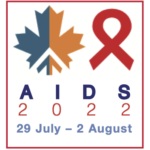AIDS 2022: Gender-affirming hormones, weight gain and ART
3 October 2022. Related: Conference reports, PK and drug interactions, Side effects, World AIDS 24 Montreal 2022.
Kirk Taylor, HIV i-Base
 An overview on gender-affirming hormone therapy, weight gain and ART presented by Emilia Jalil from FIOCRUZ, Brazil, included a report that trans women (TW) gain more weight on INSTI or TAF-based regimens than trans men (TM). [1]
An overview on gender-affirming hormone therapy, weight gain and ART presented by Emilia Jalil from FIOCRUZ, Brazil, included a report that trans women (TW) gain more weight on INSTI or TAF-based regimens than trans men (TM). [1]
This is important as transgender people have disproportionate risk of becoming HIV positive and are considered a priority group for prevention and care strategies. ART studies tend to recruit low numbers of trans participants and lack disaggregated trans data.
Approximately 50% of transgender people take gender-affirming hormones, with a further 30% having considered hormone therapy. TW receive anti-androgen plus oestrogen therapies that cause physical changes (ie reduced muscle mass and body fat redistribution), and favourable lipid profile changes.
Testosterone therapy for TM drives development of masculine secondary characteristics. Testosterone increases muscle mass, redistributes body fat, and worsens lipid profiles (raising LDL, cholesterol and triglycerides and lowering HDL).
Weight gain is associated with gender affirming hormones with increases seen within 4 months for TM and after 22 months for TW. TM report higher rates of obesity and weight gain.
Although many HIV drugs do not interact with hormone therapy, it is important to be aware of drug-drug interactions with some drugs and to consider potential adverse effects. Doctors need to understand these data in order to reduce the risk of altered adherence by trans people. [2]
The ADVANCE study reported weight gain in trans people using three commonly-used first-line combinations. At week-144, weight gain occurred with all regimens with the greatest increases observed for TW: TAF/FTC/DTG (+12.3 kg for TW vs +7.2 kg for TM) >TDF/FTC/DTG (+7.4 kg for TW vs +5.5 kg for TM) >TDF/FTC/EFV (+5.5 kg for TW vs +2.6 kg for TM). [3]
Although CAB-LA injections were not associated with weight gain in HIV negative participants in the HPTN 077 PrEP study, when used as treatment, injectable CAB-LA/RPV-LA in people living with HIV, weight increases were similar to dolutegravir-based ART. [4, 5]
More work is required to overcome knowledge gaps due to trials not enrolling enough trans people and/or lack of trans-specific analyses.
comment
Liverpool University publish a comprehensive resource on potential drug interactions between ART and hormone treatment which is also updated id new data become available. [2]
References
- Jalil EM. Hormones, trans populations, and metabolic consequences. Metabolic consequences of new classes of ART. AIDS 2022 (Montreal). 29 July to 2 August 2022.
programme.aids2022.org/Programme/Session/23 - Liverpool University Drug Interaction Website. Hormone therapy for gender transitioning, (February 2019 update).
https://liverpool-hiv-hep.s3.amazonaws.com/prescribing_resources/pdfs/000/000/007/original/Hormone_Chart_2019_Feb.pdf - Sokhela SM. The ADVANCE trial: Phase 3, randomised comparison of TAF/FTC+DTG, TDF/FTC+DTG or TDF/FTC/EFV for first-line treatment of HIV-1 infection. AIDS 2020 (Virtual). 6 to 10 July 2020.
programme.aids2020.org/Abstract/Abstract/10954 (abstract)
programme.aids2020.org/Programme/Session/44 (webcast) - Landovitz RJ et al. Cabotegravir Is Not Associated With Weight Gain in Human Immunodeficiency Virus-uninfected Individuals in HPTN 077. Clin Infect Dis. 2020 Jan 2;70(2):319-322. doi: 10.1093/cid/ciz439.
- Taylor K. Long-acting CAB/RPV injections have a similar weight and lipid profile to dolutegravir-based oral ART. HTB (1 September 2022).
i-base.info/htb/43782

